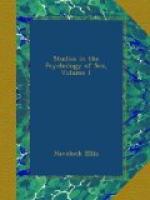[131] As regards the northern tribes of Central Australia, Spencer and Gillen state that, during the performance of certain ceremonies which bring together a large number of natives from different parts, the ordinary marital rules are more or less set aside (Northern Tribes of Central Australia, p. 136). Just in the same way, among the Siberian Yakuts, according to Sieroshevski, during weddings and at the great festivals of the year, the usual oversight of maidens is largely removed. (Journal of the Anthropological Institute, Jan.-June, 1901, p. 96.)
[132] R.E. Guise, Journal of the Anthropological Institute, 1899, pp. 214-216.
[133] Dalton, Ethnology of Bengal, pp. 196 et seq. W. Crooke (Journal of the Anthropological Institute, p. 243, 1899) also refers to the annual harvest-tree dance and saturnalia, and its association with the seasonal period for marriage. We find a similar phenomenon in the Malay Peninsula: “In former days, at harvest-time, the Jakuns kept an annual festival, at which, the entire settlement having been called together, fermented liquor, brewed from jungle fruits, was drunk; and to the accompaniments of strains of their rude and incondite music, both sexes, crowning themselves with fragrant leaves and flowers, indulged in bouts of singing and dancing, which grew gradually wilder throughout the night, and terminated in a strange kind of sexual orgie.” (W.W. Skeat, “The Wild Tribes of the Malay Peninsula,” Journal of the Anthropological Institute, 1902, p. 133.)
[134] Fielding Hall, The Soul of a People, 1898, Chapter XIII.
[135] See e.g., L. Dyer, Studies of the Gods in Greece, 1891, pp. 86-89, 375, etc.
[136] For a popular account of the Feast of Fools, see Loliee, “La Fete des Fous,” Revue des Revues, May 15, 1898; also, J.G. Bourke, Scatologic Rites of all Nations, pp. 11-23.
[137] J. Grimm (Teutonic Mythology, p. 615) points out that the observance of the spring or Easter bonfires marks off the Saxon from the Franconian peoples. The Easter bonfires are held in Lower Saxony, Westphalia, Lower Hesse, Geldern, Holland, Friesland, Jutland, and Zealand. The Midsummer bonfires are held on the Rhine, in Franconia, Thuringia, Swabia, Bavaria, Austria, and Silesia. Schwartz (Zeitschrift fuer Ethnologie, 1896, p. 151) shows that at Lauterberg, in the Harz Mountains, the line of demarcation between these two primitive districts may still be clearly traced.




